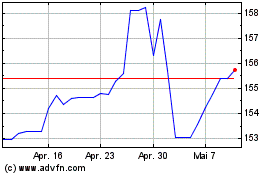U.S. Dollar Falls After Trump's Speech
31 Januar 2018 - 4:58AM
RTTF2
The U.S. dollar declined against its major counterparts on
Wednesday, after U.S. President Donald Trump outlined policies on
trade, immigration, infrastructure and national security in his
first State of the Union address.
Trump was optimistic over strength of the U.S. economy and tax
reduction measures and he urged Congress to pass a $1.5 trillion
infrastructure spending plan.
Trump said that America has "turned the page on decades of
unfair trade deals that sacrificed our prosperity and shipped away
our companies, our jobs and our nation's wealth."
President Trump reiterated his offer of a path to citizenship to
1.8 million undocumented immigrants and made case to scale back
legal immigration and build border wall.
The Federal Reserve's latest two-day monetary policy meeting
concludes later today, with economists widely expecting the
benchmark rate to remain unchanged at a range between 1.25-1.50
percent.
Some economists expect the central bank to raise its economic
assessment at Fed Chair Janet Yellen's final meeting.
The greenback weakened to a 6-day low of 0.9308 against the
franc, from a high of 0.9359 hit at 9:30 pm ET. If the greenback
declines further, it may target support around the 0.92 area.
Reversing from an early high of 109.09 against the yen, the
greenback edged down to 108.60. The next possible support for the
greenback is seen around the 106.00 level.
Data from the Cabinet Office showed that Japan's consumer
confidence held steady at the start of the year.
The seasonally adjusted consumer confidence index came in at
44.7 in January, the same reading as in December.
The greenback hit a 5-day low of 1.4213 against the pound,
following a high of 1.4136 hit at 9:30 pm ET. On the downside, 1.45
is possibly seen as the next support level for the greenback.
Having advanced to 1.2397 against the euro at 6:30 pm ET, the
greenback reversed direction and dropped to a 5-day low of 1.2463.
The greenback is seen finding support around the 1.26 level.
Data from Destatis showed that Germany's retail sales declined
unexpectedly in December.
Retail sales fell 1.9 percent year-on-year in December, in
contrast to November's 4.3 percent increase.
The greenback dropped to a 4-1/2-month low of 1.2272 against the
loonie and a weekly low of 0.7403 against the kiwi, from its early
highs of 1.2348 and 0.7327, respectively. Continuation of the
greenback's downtrend may see it challenging support around 1.20
against the loonie and 0.76 against the kiwi.
The greenback eased back to 0.8101 against the aussie, reversing
from an early high of 0.8046. The greenback is poised to challenge
support around the 0.82 area.
Data from the Australian Bureau of Statistics showed that
Australia's consumer prices climbed 0.6 percent on quarter in the
fourth quarter of 2017.
That was shy of expectations for 0.7 percent, although it was
unchanged from the three months prior.
Looking ahead, German jobless rate and Swiss economic sentiment
index for January, Eurozone jobless rate for December and advanced
consumer prices for January are due in the European session.
At 8:15 am ET, ADP private payrolls data for January is due.
In the New York session, Canada GDP data for November and
industrial product price index for December, as well as U.S.
pending home sales for the same month are set for release.
At 2:00 pm ET, the Fed announces decision on interest rates.
Economists widely expect the benchmark rate to remain unchanged at
a range between 1.25-1.50 percent.
US Dollar vs Yen (FX:USDJPY)
Forex Chart
Von Mär 2024 bis Apr 2024

US Dollar vs Yen (FX:USDJPY)
Forex Chart
Von Apr 2023 bis Apr 2024
